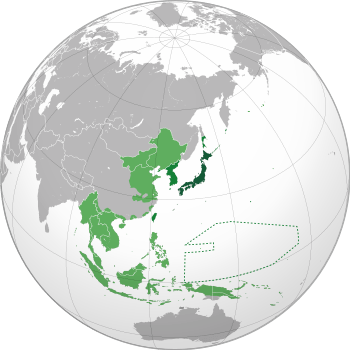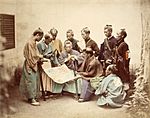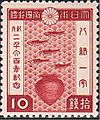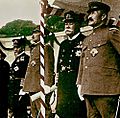Empire of Japan facts for kids
Quick facts for kids
Empire of Japan
大日本帝国
Dai Nippon Teikoku |
|||||||||
|---|---|---|---|---|---|---|---|---|---|
| 1868–1947 | |||||||||

The Empire of Japan's territorial control at its peak during World War II (mid 1942):
|
|||||||||
| Historical era | Meiji • Taishō • Shōwa | ||||||||
|
• Established
|
3 January 1868 | ||||||||
|
• Disestablished
|
3 May 1947 | ||||||||
|
|||||||||
 |
|---|
|
| Empire of Japan | |||||
|---|---|---|---|---|---|
| Japanese name | |||||
| Kanji | 大日本帝国 | ||||
| Hiragana | だいにっぽんていこく だいにほんていこく |
||||
| Katakana | ダイニッポンテイコク ダイニホンテイコク |
||||
| Kyūjitai | 大日本帝國 | ||||
|
|||||
The Empire of Japan (in Japanese: 大日本帝国, pronounced Dai Nippon Teikoku) was the name for Japan's government and the lands it ruled from 1868 to 1945. This period began with the Meiji Restoration. It ended when Japan lost World War II.
During this time, Japan was led by three Emperors. They were Emperor Meiji (Mutsuhito), Emperor Taishō (Yoshihito), and Emperor Shōwa (Hirohito).
Contents
How Japan Became a World Power
In these years, Japan changed a lot. It went from being a country focused on farming to one with a strong industrial economy. Japan built a very powerful army and navy. This made Japan one of the strongest countries in the world.
Expanding Japan's Influence
As Japan grew stronger, it started to expand its control. Japanese forces began to invade and take over nearby countries. They wanted more resources for their growing industries.
Countries like Korea, Taiwan, and parts of China became part of Japan's empire. This expansion led to many conflicts.
The End of the Empire
The Empire of Japan fought a long war against the Allied nations in World War II. The war ended for Japan on September 2, 1945. This happened after the atomic bombs were dropped on Hiroshima and Nagasaki.
After the war, the Allied forces occupied Japan. They helped Japan make many big changes. One major change was creating a new constitution. The Allies stayed in Japan and helped rebuild the country until the 1950s.
Images for kids
-
Prominent members of the Iwakura mission. Left to right: Kido Takayoshi, Yamaguchi Masuka, Iwakura Tomomi, Itō Hirobumi, Ōkubo Toshimichi
-
Emperor Meiji, the 122nd emperor of Japan
-
Ōura Church, Nagasaki
-
Baron Masuda Tarokaja, a member of the House of Peers (Kazoku). His father, Baron Masuda Takashi, was responsible for transforming Mitsui into a zaibatsu.
-
Marunouchi District in 1920, looking towards the Imperial Palace
-
Thomas Blake Glover was a Scottish merchant in Bakumatsu and received Japan's second highest order from Emperor Meiji in recognition of his contributions to Japan's industrialization.
-
Prince Katsura Tarō, thrice Prime Minister and the Lord Keeper of the Privy Seal of Japan. Katsura commanded the IJA 3rd Division under his mentor, Field Marshal Yamagata Aritomo, during the First Sino-Japanese War.
-
Marquess Komura Jutaro, 1911. Komura became Minister for Foreign Affairs under the first Katsura administration, and signed the Boxer Protocol on behalf of Japan.
-
Count Tadasu Hayashi was the resident minister to the United Kingdom. While serving in London from 1900, he worked to successfully conclude the Anglo-Japanese Alliance and signed on behalf of the government of Japan on January 30, 1902.
-
Emperor Taishō, the 123rd emperor of Japan
-
Native Micronesian constables of Truk Island, circa 1930. Truk became a possession of the Empire of Japan under a mandate from the League of Nations following Germany's defeat in World War I.
-
Commanding Officers and Chiefs of Staff of the Allied Military Mission to Siberia, Vladivostok during the Allied Intervention
-
Groundbreaking ceremony of Ginza Line, the oldest subway line in Asia, 1925. Front row, right to left: Rudolf Briske, Noritsugu Hayakawa, Furuichi Kōi, Ryutaro Nomura.
-
Count Katō Komei, the 14th Prime Minister of Japan from June 11, 1924, until his death on January 28, 1926
-
Rebel troops assembling at police headquarters during the February 26 Incident
-
National Diet Building, 1930
-
Japanese troops entering Shenyang, Northeast China during the Mukden Incident, 1931
-
The Japanese occupation of Peiping (Beijing) in China, on August 13, 1937. Japanese troops are shown passing from Peiping into the Tartar City through Zhengyangmen, the main gate leading onward to the palaces in the Forbidden City.
-
IJN Special Naval Landing Forces armed with the Type 11 Light Machine Gun during the Battle of Shanghai, 1937
-
Founding ceremony of the hakkō ichiu monument on April 3, 1940. It had Prince Chichibu's calligraphy of hakkō ichiu carved on its front side.
-
Emperor Shōwa and Empress Kōjun presiding the celebration of the 2600th anniversary of mythical foundation of the Empire in November 1940
-
Japanese pilots who gathered under the flag of hakkō ichiu during the Pacific War
-
Victorious Japanese troops march through the city center of Singapore following the city's capture in February 1942 (Photo from the Imperial War Museum)
-
Imperial Japanese Army paratroopers are landing during the Battle of Palembang, February 13, 1942.
-
A model representing the attack by dive bombers from USS Yorktown and USS Enterprise on the Japanese aircraft carriers Sōryū, Akagi and Kaga in the morning of June 4, 1942, during the Battle of Midway
-
The rebuilt battlecruiser Haruna sank at her moorings in the naval base of Kure on July 24 during a series of bombings.
-
The Japanese archipelago and the Korean Peninsula in 1945 (National Geographic)
-
A drawing depicting a speech in the Imperial Japanese Diet on November 1, 1945, the end of the Second World War. In the foreground there are several Allied soldiers watching the proceedings from the back of the balcony.
-
From left to right: Marshal Admiral Heihachirō Tōgō (1848–1934), Field Marshal Oku Yasukata (1847–1930), Marshal Admiral Yoshika Inoue (1845–1929), Field Marshal Kageaki Kawamura (1850–1926), at the unveiling ceremony of bronze statue of Field Marshal Iwao Ōyama
See also
 In Spanish: Imperio del Japón para niños
In Spanish: Imperio del Japón para niños


















































